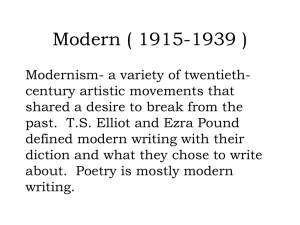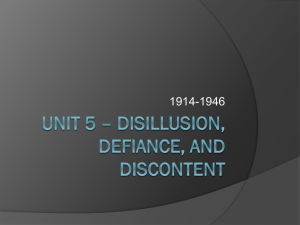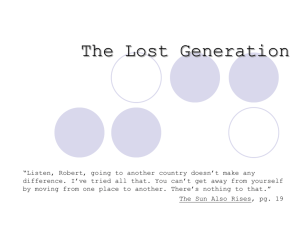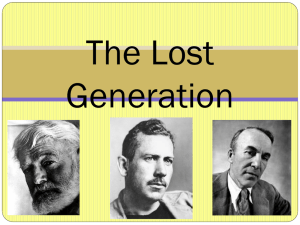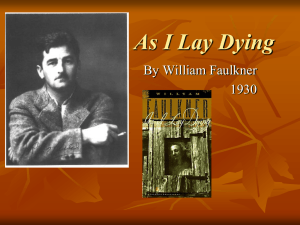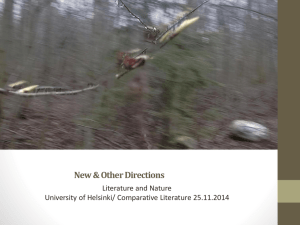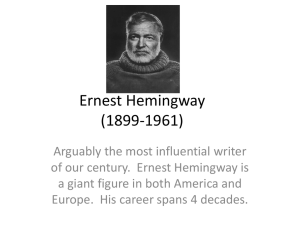Modern American Novel Fifth Lecture Mrs. Nouf Al
advertisement
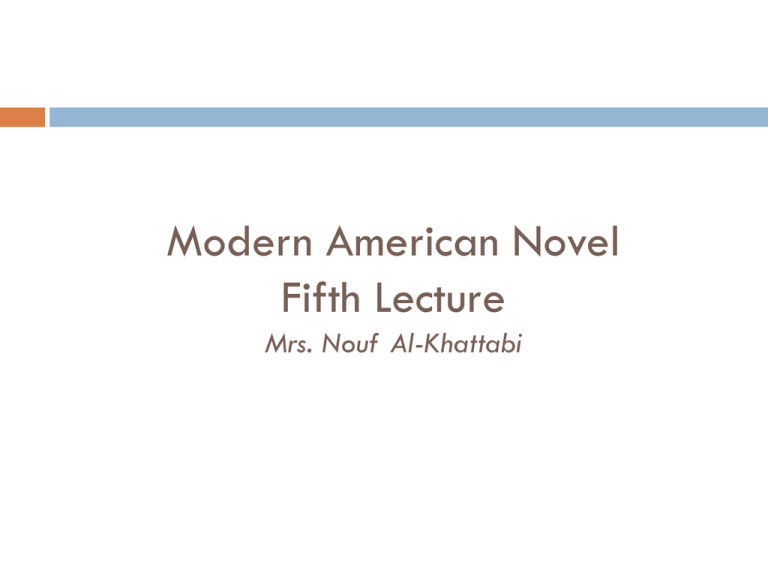
Modern American Novel Fifth Lecture Mrs. Nouf Al-Khattabi The Writers of the “Lost Generation” The "Lost Generation" is a term used to characterize a general feeling of disillusionment in American literture. The term is used for the period from the end of World War I to the beginning of the Great Depression, though in the United States it is used for the generation of young people who came of age during and shortly after World War I, alternatively known as the World War I Generation. The Writers of the “Lost Generation” During this time many American lost their ideals. At the same time America lost many fine writers. The Lost Generation writers felt that America was not such a success story because the country was devoid of a cosmopolitan culture. Their solution to this issue was to pack up their bags and travel to Europe’s cosmopolitan cultures, such as Paris and London. Here they expected to find literary freedom and a cosmopolitan way of life. The Writers of the “Lost Generation” Why was it significant to American Culture? This temporary emigration of American talent into cosmopolitan cities such as Paris, is significant to American culture in two parts. One, because it aided in the desire for a cosmopolitan A cosmopolitan culture (a culture which includes and values a variety of backgrounds and cultures) to be established and to exist in America. Two, because when American Culture became more defined, European and other countries began to recognize a distinctive Democratic American culture. F. Scott Fitzgerald F. Scott Fitzgerald photographed by Carl van Vechten in 1937 Born Francis Scott Key Fitzgerald September 24, 1896(189609-24) St. Paul, Minnesota, U.S. Died December 21, 1940 (aged 44) Hollywood, California, U.S. Occupation novelist, short story writer, poet Nationality American Period 1940–1920 Genres Modernism Literary movement Scott Fitzgerald (1896-1940) Fitzgerald’s life was like the plot of one of his novels. He was born to a rich family and served in the army as a lieutenant, but he was never sent to fight in Europe. Throughout the twenties, he wrote an enormous amount of fiction which provided the money for many of his parties and wild-trips to Europe. His fiction was popular in the twenties because it was modern and easy to read. In 1929, the American economy collapsed starting the Great Depression. This happened at a time when Fitzgerald himself to have serious mental and physical health problems. Scott Fitzgerald (1896-1940) Although Fitzgerald, like Nick Carraway in his novel, The Great Gatsby (1925), idolized the riches and glamor of the age, he was uncomfortable with the unrestrained materialism and the lack of morality that went with it, a kind of decadence. The novel combines symbolism with psychological realism. Gatsby, the hero symbolizes the American belief that money can buy love and happiness. His failure makes him a tragic hero. The novel is also famous for its unusual use of colors. Ernest Hemingway Hemingway in 1939 Born July 21, 1899(1899-07-21) Oak Park, Illinois, United States Died July 2, 1961 (aged 61) Ketchum, Idaho, United States Nationality American Nobel Prize in Literature Notable award(s) 1954 Pulitzer Prize for Fiction – 1953 Ernest Hemingway (1898-1961) Hemingway spoke for the Lost Generation as Fitzgerald. He drove an ambulance in World War I and then decided to live in Paris and become a writer. Hemingway’s simple style and careful structuring of his fiction is famous. The aim of his style is to “get the most out of the least.” His sentence are usually short and simple. Sometimes, he repeats a key phrase for emphasize his theme. His language is rarely emotional. On the contrary, it controls emotions and holds them in. By the thirties, his concentrated style began to lose its freshness. Part of the problem was that many other writers were copying his style in their own works. Ernest Hemingway (1898-1961) The Sun Also Rises (1926), is a portrait of young adults of the post-war era. The characters are young Americans living Paris. They fought for their country, but they are completely useless in peacetime. All they want to know is how to live in the emptiness of the world. In later writings, Hemingway develops this emptiness to what becomes known as ‘Nada’ (‘nothingness’ in Spanish). Nada is sometimes seen as the loss of hope or the inability to become active in the real world. At other times, it is the desire for sleep, or an easy death. Hence, Hemingway’s hero must always fight against the Nada of the world. Ernest Hemingway (1898-1961) Men Without Women (1927), a short collection of short stories, mixes psychological realism with symbolism. They are very easy to read. Therefore, readers sometimes miss their deep meanings. The Old Man and the Sea (1952), Its an allegory of human life. This novel received the Pulitzer Prize in 1952. In 1954, he was awarded the Nobel Prize for Literature. As he grew older, he felt his powers as an artist were failing, so in 1961, he shot himself with his favorite hunting gun. John Dos Passos (1896-1970) Like other members of the lost generation, Passos saw the modern, post-war world as ugly and dirty. According to him only art can save the world and put an end to destruction. His first successful modern novel is Manhattan Transfer (1925), which describes the daily activities of a large group of people living in New York. In this novel, he has been influenced by the techniques of the movies. For example, he uses the montage technique.’ HOW? John Dos Passos (1896-1970) In the 1930s, Passos published the first volume of his great ‘U.S.A.’ trilogy. The trilogy shows how individuals are part of the history of the age in which they live. All three books: The 42nd Parallel, 1919, and The Big Money use the movie techniques to tell the history of the entire nation in the early twentieth century. The quality of Passos literature began to decline after his trilogy. William Faulkner Faulkner in 1954, photograph by Carl Van Vechten Born William Cuthbert Falkner September 25, 1897(189709-25) New Albany, Mississippi, USA Died July 6, 1962 (aged 64) Byhalia, Mississippi, USA Occupation Novelist, short story writer Genres Southern Gothic Literary movement Modernism, Stream of consciousness Notable award(s) Nobel Prize in Literature, 1949 William Faulkner (1897-1962) In his works Faulkner used a small number of characters, who all represent the South region. They often reaper in later novels. Faulkner shared two things with the Lost Generation: (1) its strong dislike for the post-war world and (2) its belief in the value of art. In almost all of Faulkner’s stories, time is treated in a special way. He uses the ‘continuous present, style of writing. Past, present and future events are mixed. Hence, it is usually hard to read his works. Faulkner’s description of human goodness is as powerful as his description of human evil. Often his good people are black. His characters show their goodness in their relationship with nature and their ability to love. William Faulkner (1897-1962) The Sound and the Fury (1929), is one of his ‘modernist’ masterpieces. There are many experimental features in this novel. (1)On e feature is the use of limited point of view. Each of the characters sees reality according to her\his way.(2) Another feature is his special technique of narration where the reader is put into the center of the story without any preparation. Readers must put together facts together since the author does not help them. Light in August (1932), is considered as another masterpiece. It shows how racism makes the white community of the South go crazy.
